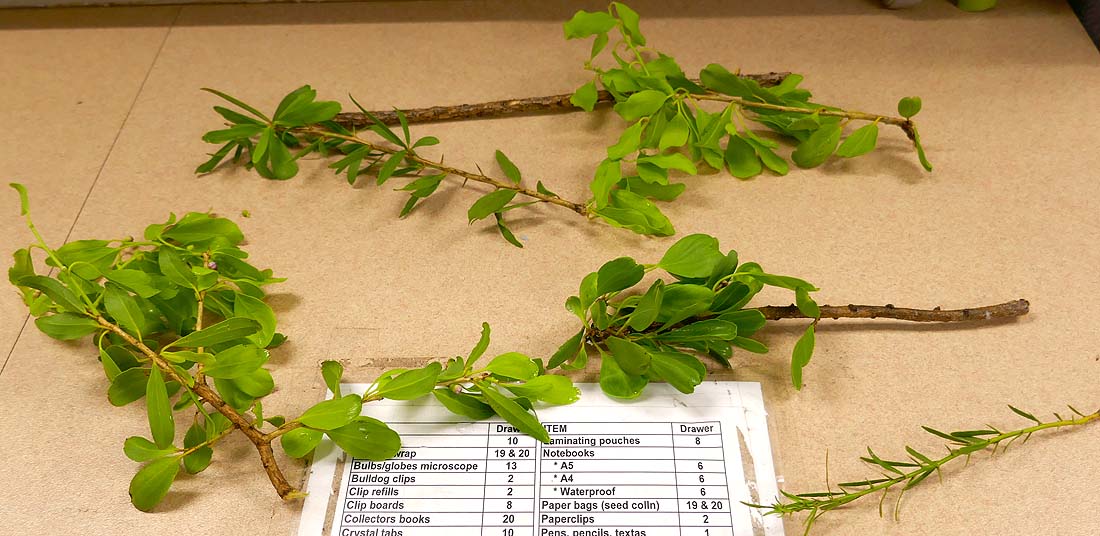

part 2
My visit to Mataranka was to be the final highlight of my trip to Australia. From Darwin, I drove to Katherine to visit the beautiful Nitmiluk National Park, previously known as Katherine Gorge. Another hour's drive took me to Mataranka where I met Garry Riggs, owner of Lakefield Station, a cattle ranch some 40kms further south and down the unsealed Gorrie Dry River Road. Garry had promised to show me several groups of fruiting Citrus gracilis on his property. These are well outside the published range of this species.
I had imagined Lakefield Station to be a modern farm business, with up-to-date commercial buildings and equipment and several staff. I was completely mistaken. This was very much a family-run operation, a bit ramshackle in places and lots of old machinery and equipment lying around. The only staff were two young Australian teenagers - one of whom had a minor accident while I was there and required transportation to Katherine hospital; the other disappeared in a huff back to home in Darwin! Garry and his wife were clearly a very practical hands-on team who could turn their hands to anything required. They had improved the land over several decades with fencing and water supplies for the cattle and had won awards for the protection of the environment, flora and fauna. For me this brief visit was an eye-opener into a world very different from rural England. Temperatures were at times in excess of 40C.

The junction of the Stuart Highway and the unsealed road to Lakefield Station

The Ghan Railway runs through Lakefield Station land about 18kms from the homestead

Here are some of Garry's cattle grazing on new growth after early rains marking the end of the dry.season. The remnants of Lake Duggan are in the distance.
The best individual specimen of Citrus gracilis was actually in a fenced cattle stockpen not far from Lake Duggan. It had been first noticed and identified when carrying a number of large fruits. Unfortunately, by the time I arrived the seasons fruits had all fallen and disappeared. This was probably caused by the unexpectedly early first rains which triggered a new flush of growth and flowers. A nicely-shaped small tree about 5 metres tall - lower twigs perhaps removed by cattle. No thin leaves - all the broader form.


Fruitlets, many of which had fallen, were roughly spherical but with a broad neck. Flowers white. Virtually no thorns.


GPS: -15.080662, 132.693359

The other area of C. gracilis trees (shown here by the light green at top left) had only been found a couple of months before my visit, yet was less than 1km from the homestead (the red dot).
This image from BingMaps also shows the plantation of mangos near the homestead, and the remains of a citrus area (now white) which had been destroyed by termites.
This image from BingMaps also shows the plantation of mangos near the homestead, and the remains of a citrus area (now white) which had been destroyed by termites.
There were many specimens here, varying from hundreds of small suckers to small trees - and all stages in between. Suckers had the expected very thin linear leaves. Intermediate trees had larger leaves growing in 'tufts' on older twigs. Larger trees had much broader leaves, some almost round with several central veins - quite unlike any other citrus I have seen. Flower buds here were very distinctly purple.








Some of the fruit, now dry and mouldy, which had been collected about a month before my visit.
Finally, these are the samples I took to the Northern Territory Herbarium in Palmerston near Darwin. I included twigs with the different leaf stages.
Click these links!

Mataranka and Lakefield Station (orange rectangle) are bottom right of this Northern Territory map. It takes about 6 hours driving from Darwin at top left.
GPS: -15.268681, 132.904459
See Lakefield Station's Tumblr blog for some great photos!
These samples are now included in Australia's Virtual Herbarium. The section of plant material on the left was sent to the National Herbarium of Victoria in Melbourne.

The left picture shows the branch before pressing and drying.
The right image is the final herbarium sheet from the National Herbarium of Victoria in Melbourne.
This sheet was photographed for me by the herbarium and their high definition original is available for study by clicking here or on the photo.
WARNING - 23MB large image file download
The right image is the final herbarium sheet from the National Herbarium of Victoria in Melbourne.
This sheet was photographed for me by the herbarium and their high definition original is available for study by clicking here or on the photo.
WARNING - 23MB large image file download
"Reproduced with permission from the Royal Botanic Gardens Victoria."

